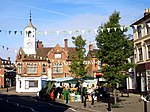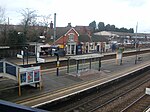Redborne Upper School and Community College
Redborne Upper School & Community College is an academy school and sixth-form located in Ampthill, Bedfordshire, England. The school serves the population of Ampthill, Flitwick and surrounding villages. Redborne is a designated Training school. As a training school the school offers a postgraduate programme as well as a Graduate Teacher Programme, and an Access to Education Scheme. Through this the school has links with the University of Bedfordshire, Oxford Brookes University and Bedford College. In July 2019, the school was awarded an Artsmark gold award from Arts Council England. The award is in recognition of the school's excellence in arts education.The school was previously a specialist Sports College, however on 1 April 2011, the school formally gained academy status. The school also has a working farm allowing a qualification in agriculture.As of 2019, the school's most recent Ofsted judgement was Good (2017).
Excerpt from the Wikipedia article Redborne Upper School and Community College (License: CC BY-SA 3.0, Authors).Redborne Upper School and Community College
Flitwick Road,
Geographical coordinates (GPS) Address External links Nearby Places Show on map
Geographical coordinates (GPS)
| Latitude | Longitude |
|---|---|
| N 52.019 ° | E -0.497 ° |
Address
Redborne Upper School and Community College
Flitwick Road
MK45 2NT
England, United Kingdom
Open on Google Maps







